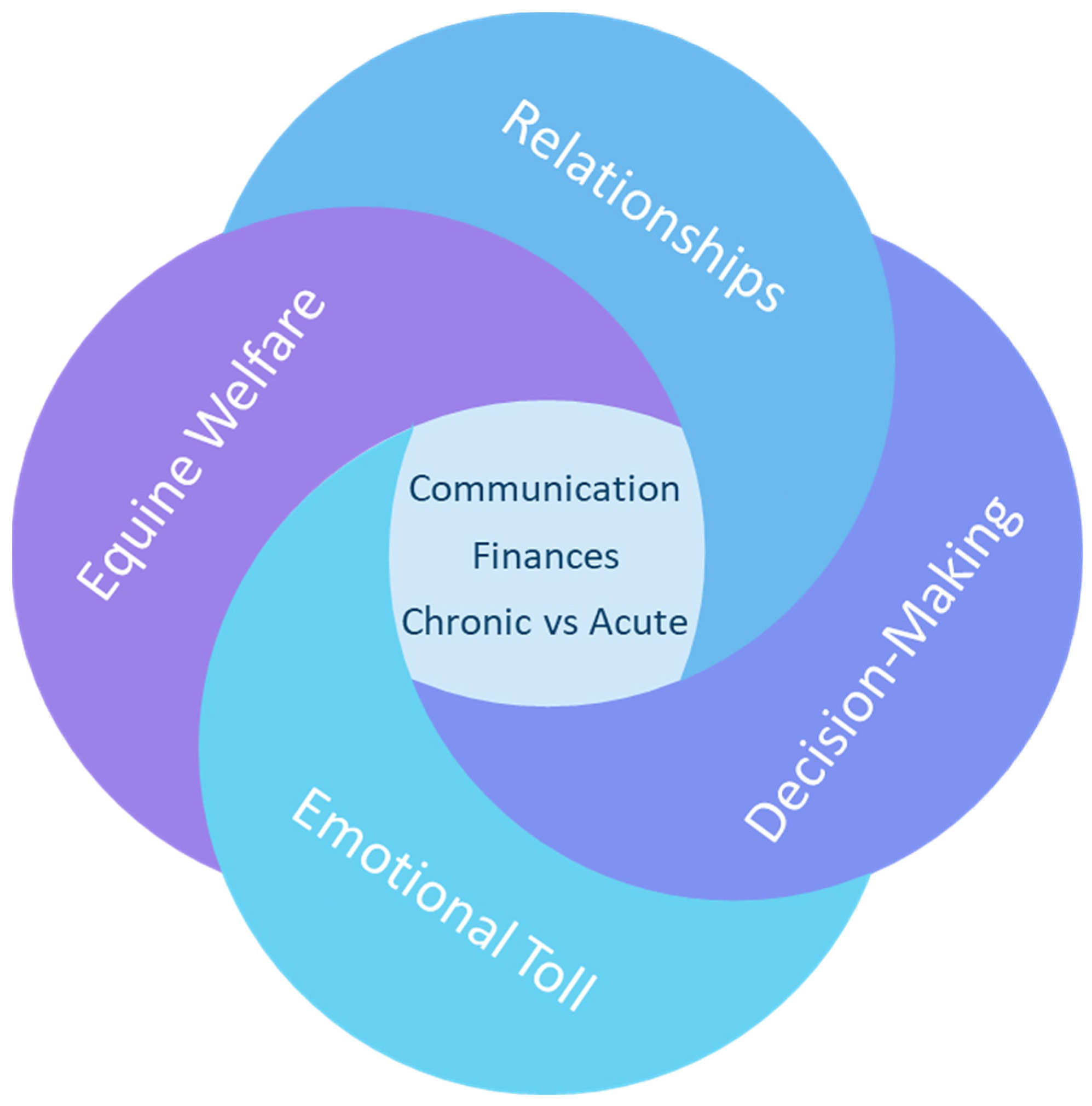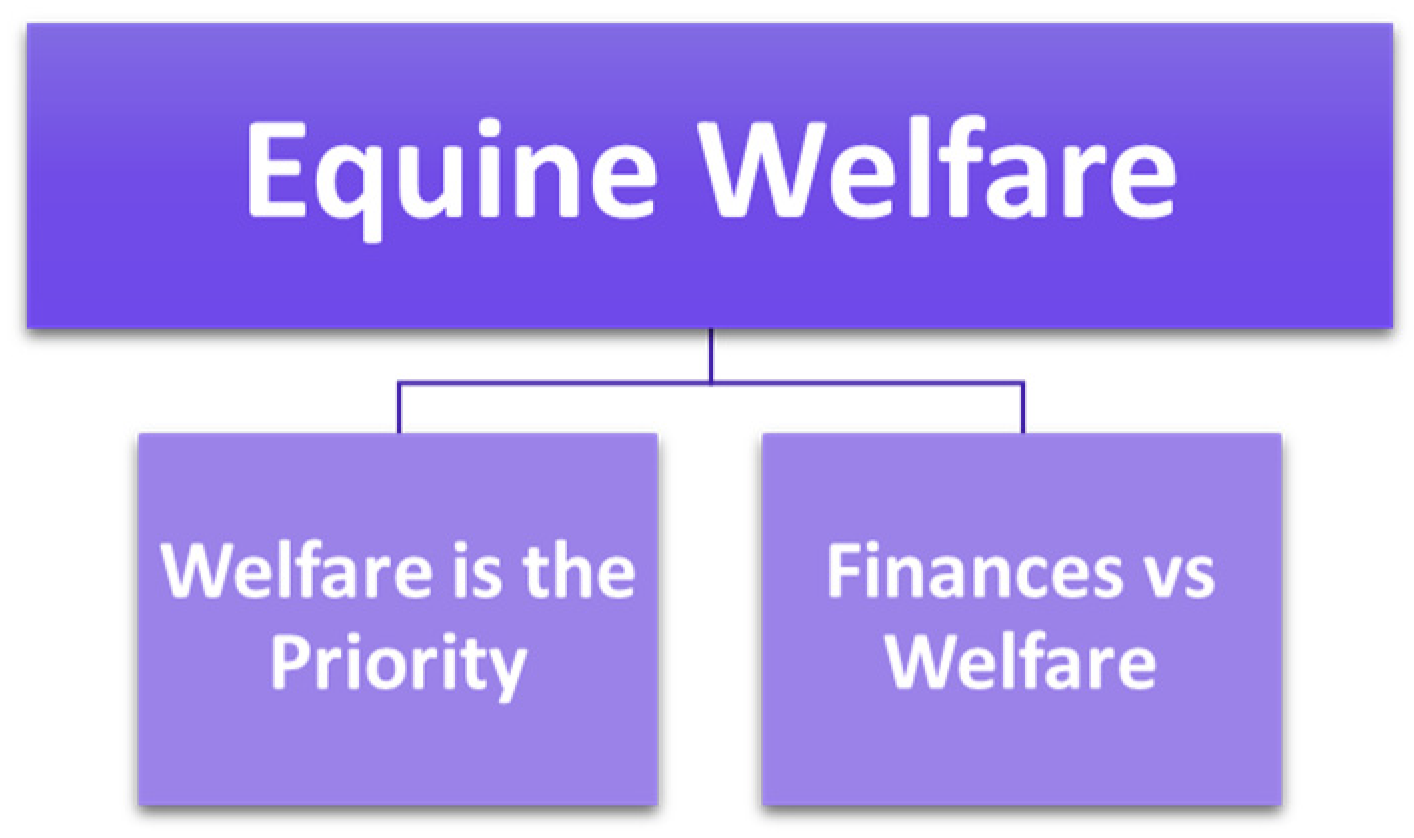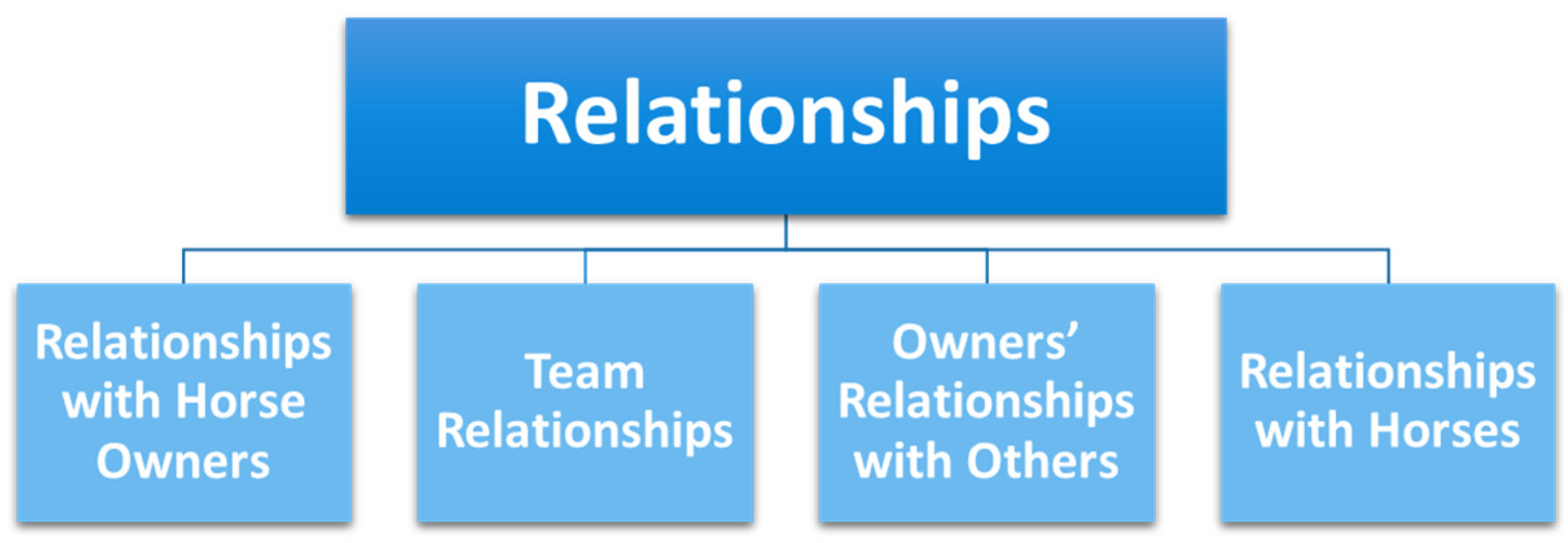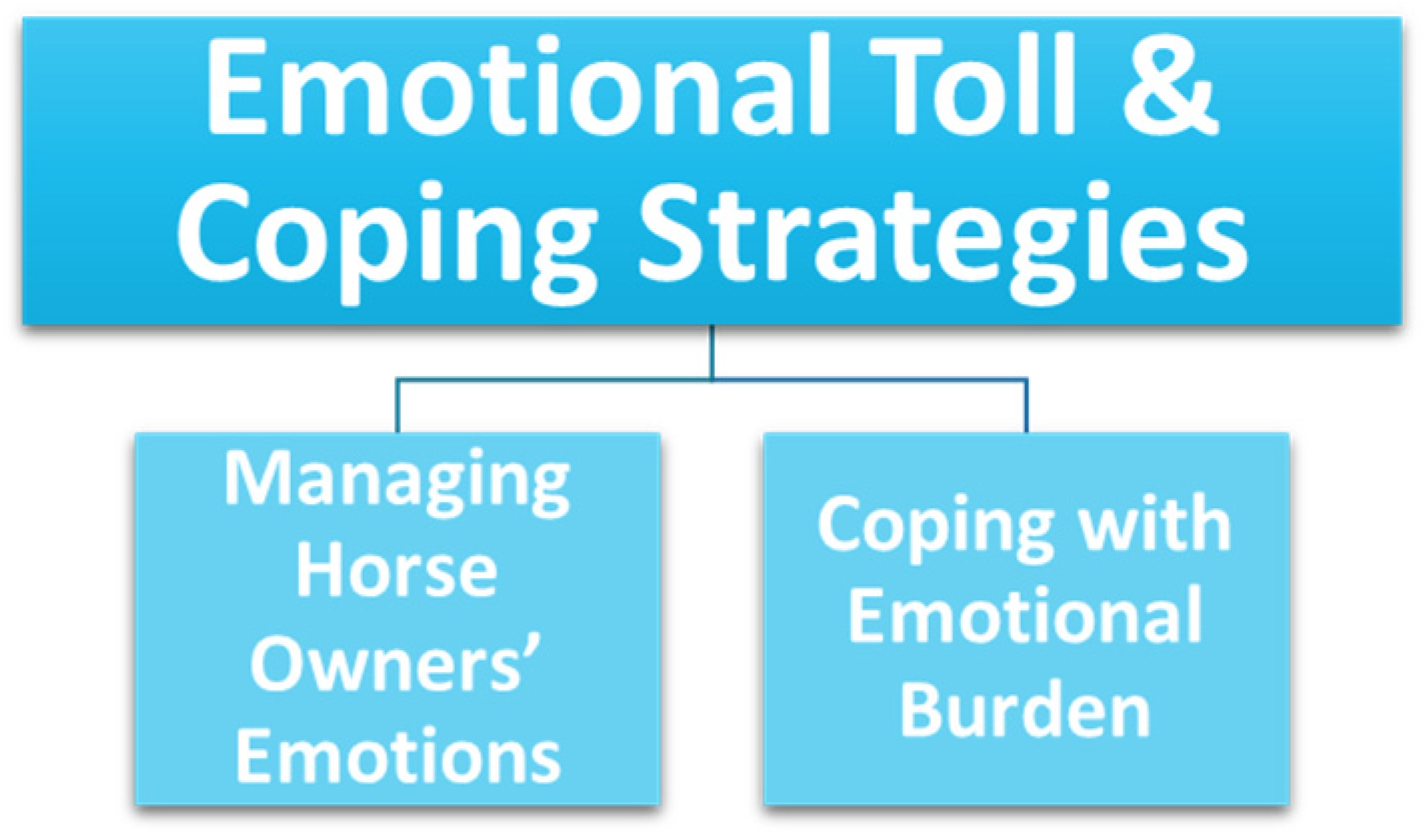Experiences of End-of-Life Decision-Making in Equine Veterinary and Charity Teams
Simple Summary
Abstract
1. Introduction
2. Materials and Methods
2.1. Study Design
2.2. Recruitment
2.3. Participants
2.4. Data Collection
2.5. Data Analysis
2.5.1. Transcription
2.5.2. Coding and Theme Generation
3. Results
3.1. Overview
3.2. Equine Welfare
3.2.1. Welfare Is the Priority
[Telling owners] “You know it’s currently not in a really bad shape so I would rather do it now than when he’s suffering and can’t get up…”Rosewood, Veterinary Intern
“Well, let’s do a pain relief trial and I want you to keep a diary”…that almost flicks the switch of “this is pain related”. So then when that horse does start to deteriorate, there’s then a recognition that rather than, “oh, he is looking old again,”, it’s, “he’s in pain again.”Poppy Ridge Charity, Veterinary Surgeon
…no horse really, very, very rarely does a horse just die peacefully. It dies because it has spent all night trying to get to its feet. As a prey animal, it knows, if I can’t get to my feet, I’m somebody’s dinner, and it struggles and panics…High Oaks, Veterinary Surgeon 3
3.2.2. Finances vs. Welfare
…we spent a week trying to tell the owner that it needed to come in and she kept saying she had absolutely no money…and it got to an emergency on the Saturday where the horse was nigh on nearly dead. But she suddenly said, ‘I’ve got £10,000, please save my horse’, and the horse, the horse collapsed while trying to load it onto the box…Whitedale, Veterinary Surgeon 1
We see a lot of horses that need colic surgery, and either owners aren’t insured, or they’re insured and insurance is generally up to [£]5000, and nowadays we can’t do colic surgery for [£]5000.Whitedale, Veterinary Surgeon 1
3.3. Relationships
3.3.1. Relationships with Horse Owners
It’s being able to build that relationship, so the client is confident in having that chat and maybe having a discussion about when the time is right…High Oaks, Veterinary Surgeon 1
…the next day she turned up with two bunches of flowers for both the vets…because she knew she’d been really abusive. But you know, often clients are really stressed, so we get a lot of the brunt of them being shitty with us…Whitedale, Veterinary Surgeon 1
3.3.2. Team Relationships
…there’s nothing more true than it’s okay not to be okay. And, you know, it’s important we do share that burden essentially.Whitedale, Veterinary Surgeon 5
So, it’s easy for us to sit back and make the decisions and do it professionally. But actually, it’s the understanding that…it’s going to affect [the grooms] differently. And I think we’ve all learnt to really offer that support as well, that anyone can walk up to anyone and talk about it.Poppy Ridge Charity, Charity Staff Member 4
I think that’s where we’ve had problems in the past…it’s been where that decision hasn’t been sort of really communicated properly by, like you say, whoever the vet was at the time.Poppy Ridge Charity, Charity Staff Member 1
3.3.3. Owners’ Relationships with Others
3.3.4. Relationships with Horses
If they were a little bit more of a professional, they’ll perhaps be more detached and more readily open to [euthanasia] as an option…Rosewood, Receptionist
…I did that with Stormy, you know, I had to escalate it because I was too emotionally involved.Poppy Ridge Charity, Charity Staff Member 3
3.4. Decision-Making
3.4.1. Decision-Making Styles
…they know them so well and you’ve got to get them onside, and you’ve got to make that decision all together like the owner and vet.Whitedale, Veterinary Surgeon 6
[In an emergency] People are usually quite distressed, emotional…and actually they need the vet to be making decisions and to give the owner very black and white decisions.Rosewood, Veterinary Surgeon 2
…it’s equally as important that we come in and take that burden off the owner, so that it’s less of a decision.Whitedale, Veterinary Surgeon 5
You’re not telling them that that’s what they’ve got to do, but you’re giving them an honest opinion of what you think the future holds for it, what the options are for them and what your advice is as to which option they should take.Rosewood, Veterinary Surgeon 2
3.4.2. Roles in Decision-Making
…we’re not there to police them, we’re there to advise them…we must never try to be dictatorial to clients, that’s not our role.High Oaks, Veterinary Surgeon 2
…we’re there to support them through their decision…whether it be holding their horse because they can’t, or…they just want to talk to somebody different, so, you can be an ear to listen to if they’ve not got a supportive friend to phone.High Oaks, Nurse
…just making sure that they have confidence in you that we’re going to get someone there to them. And just making sure that you end the phone call in a calm way, and making sure that they know that their horse is going to get the best care.Whitedale, Receptionist
…we tend to monitor when in the month horses are put to sleep, and we then decide when we’re going to send the invoice.High Oaks, Office Manager
3.4.3. Strategies for Reaching a Decision
If they’re completely blind to it, you don’t want to go straight in for something they’re not expecting. But you just want to…sort of plant a seed that actually things aren’t quite right, and hopefully they can then come to the conclusion themselves, with a bit of assistance.Rosewood, Veterinary Intern
…I’ve never had to make the decision or advise the owner about making the decision yet…I think I would find that quite a hard conversation to steer and not pressure the owner, but give firm guidance, if that make sense. So yeah, if there was something…that prompted a conversation between the two that might be quite helpful, I think.Whitedale, Veterinary Surgeon 4
3.5. Emotional Toll and Coping Strategies
3.5.1. Managing Horse Owners’ Emotions
As a professional person you should allow them to accept that release. You shouldn’t allow them at all to feel any guilt about their decision…and allow them to feel that it’s the right decision, because the vet agreed.High Oaks, Veterinary Surgeon 3
…if I really think that that was the right decision, I’ll tell them after I’ve done it…you know, “for what it’s worth, I think you made the right decision. I would have done the same thing”. I often would say it regardless of what I would’ve done. But quite a few have phoned afterwards to say that they appreciated me saying that.Rosewood, Veterinary Surgeon 1
…[the owner is] trying to make you say, “no, it’s okay, it’s the right thing to do”…I used to, when I was younger, try and sort of appease that. But I find it harder and harder to do now because it’s so upsetting for me putting down a horse that I know I can fix.Whitedale, Veterinary Surgeon 1
…she thought she was going to sleep with it until it was collected the next day. She brought clothing and laid it all over the horse…and a friend was videoing her lying next to it dead on the floor…she was dramatic vomiting outside, she was in a right mess…It was horrendous, but then you don’t want to be rude to them…But then what, what do you do in that situation?Rosewood, Nurse
I think there’s a difference between when it’s their old horse or whatever that they’ve decided he’s got to go. I think they, emotionally they’re in a probably stronger place than when it’s, “oh my God, it’s colic, it’s going to die, it’s broken it’s leg, or it’s doing this”, because then that’s like they’ve got the shock value on it.Rosewood, Receptionist
…it’s why planning these horses’ ultimate euthanasia is actually a really good thing because…you can actually do things like have the collection arranged beforehand so that all goes smoothly…High Oaks, Veterinary Surgeon 2
…the people that haven’t got the money to do it, like you can kind of say, “you know, we could do it like a nice memory board of some pictures and things and have some mane and tail”.Rosewood, Nurse
3.5.2. Coping with Emotional Burden
…ultimately there could be other traumas or ordeals that these clients [are] going through…And you often end up being a punching bag because their emotions are already running high…definitely thick skin, shake it off.Whitedale, Veterinary Surgeon 5
…I find [euthanasia] one of the most rewarding parts of my job actually, because it does resolve welfare problems, it resolves problems for clients, and you know, you see how people suffer in end-of-life…High Oaks, Veterinary Surgeon 2
4. Discussion
5. Conclusions
Supplementary Materials
Author Contributions
Funding
Institutional Review Board Statement
Informed Consent Statement
Data Availability Statement
Acknowledgments
Conflicts of Interest
References
- Batchelor, C.E.M.; McKeegan, D.E.F. Survey of the frequency and perceived stressfulness of ethical dilemmas encountered in UK veterinary practice. Vet. Rec. 2012, 170, 19. [Google Scholar] [CrossRef]
- Rioja-Lang, F.C.; Connor, M.; Bacon, H.; Dwyer, C.M. Determining a welfare prioritization for horses using a delphi method. Animals 2020, 10, 647. [Google Scholar] [CrossRef] [PubMed]
- Royal College of Veterinary Surgeons. Code of Professional Conduct for Veterinary Surgeons and Supporting Guidance. Available online: https://www.rcvs.org.uk/setting-standards/advice-and-guidance/code-of-professional-conduct-for-veterinary-surgeons/pdf/ (accessed on 3 February 2025).
- British Veterinary Association. Guide to Euthanasia. Available online: https://www.bva.co.uk/media/2981/bva_guide_to_euthanasia_2016.pdf (accessed on 3 February 2025).
- Clough, H.; Roshier, M.; England, G.; Burford, J.; Freeman, S. Qualitative study of the influence of horse-owner relationship during some key events within a horse’s lifetime. Vet. Rec. 2021, 188, e79. [Google Scholar] [CrossRef] [PubMed]
- Matte, A.R.; Khosa, D.K.; Coe, J.B.; Meehan, M.; Niel, L. Exploring pet owners’ experiences and self-reported satisfaction and grief following companion animal euthanasia. Vet. Rec. 2020, 187, e122. [Google Scholar] [CrossRef] [PubMed]
- Dow, M.; Chur-Hansen, A.; Hamood, W.; Edwards, S. Impact of dealing with bereaved clients on the psychological wellbeing of veterinarians. Aust. Vet. J. 2019, 97, 382–389. [Google Scholar] [CrossRef]
- Morris, P. Managing Pet Owners’ Guilt and Grief in Veterinary Euthanasia Encounters. J. Contemp. Ethnogr. 2012, 41, 337–365. [Google Scholar] [CrossRef]
- Testoni, I.; De Vincenzo, C.; Campigli, M.; Caregnato Manzatti, A.; Ronconi, L.; Uccheddu, S. Validation of the HHHHHMM Scale in the Italian Context: Assessing Pets’ Quality of Life and Qualitatively Exploring Owners’ Grief. Animals 2023, 13, 1049. [Google Scholar] [CrossRef]
- Arora, A.; Clarida, K.; Steffan, M.; Zamora, D.; Londono Forero, M.; Umair, A.; Danyliw, J. Final Report: Pet Loss Best Practice Guidelines for Veterinary Teams; Seneca College & VCA Canada: Toronto, ON, Canada, 2020. [Google Scholar]
- Kerrigan, L. Anticipating grief—The role of pre-euthanasia discussions. Vet. Nurse 2014, 5, 236–243. [Google Scholar] [CrossRef]
- Belshaw, Z.; Robinson, N.J.; Dean, R.S.; Brennan, M.L. Owner and veterinary surgeon perspectives on the roles of veterinary nurses and receptionists in relation to small animal preventive healthcare consultations in the United Kingdom. Vet. Rec. 2018, 183, 296. [Google Scholar] [CrossRef] [PubMed]
- Moore, I.C.; Coe, J.B.; Adams, C.L.; Conlon, P.D.; Sargeant, J.M. The role of veterinary team effectiveness in job satisfaction and burnout in companion animal veterinary clinics. J. Am. Vet. Med. Assoc. 2014, 245, 513–524. [Google Scholar] [CrossRef] [PubMed]
- Blue Cross; Bransby Horses; BHS; HorseWorld; Redwings; RSPCA; World Horse Welfare. Britain’s Horse Problem. Available online: https://storage.googleapis.com/stateless-whwwp-screenbeetle-c/2020/12/78e09200-britains-horse-problem-report-final.pdf (accessed on 27 August 2024).
- Hoy-Gerlach, J.; Ojha, M.; Arkow, P. Social workers in animal shelters: A strategy toward reducing occupational stress among animal shelter workers. Front. Vet. Sci. 2021, 8, 734396. [Google Scholar] [CrossRef] [PubMed]
- Charles, C.; Gafni, A.; Whelan, T. Decision-making in the physician–patient encounter: Revisiting the shared treatment decision-making model. Soc. Sci. Med. 1999, 49, 651–661. [Google Scholar] [CrossRef] [PubMed]
- Charles, C.; Gafni, A.; Whelan, T. Shared decision-making in the medical encounter: What does it mean? (or it takes at least two to tango). Soc. Sci. Med. 1997, 44, 681–692. [Google Scholar] [CrossRef] [PubMed]
- Cornell, K.K.; Kopcha, M. Client-veterinarian communication: Skills for client centered dialogue and shared decision making. Vet. Clin. N. Am. Small Anim. Pract. 2007, 37, 37–47. [Google Scholar] [CrossRef]
- Tong, A.; Sainsbury, P.; Craig, J. Consolidated criteria for reporting qualitative research (COREQ): A 32-item checklist for interviews and focus groups. Int. J. Qual. Health Care 2007, 19, 349–357. [Google Scholar] [CrossRef]
- Braun, V.; Clarke, V. Successful Qualitative Research: A Practical Guide for Beginners; SAGE: London, UK, 2013. [Google Scholar]
- Verhoef, M.J.; Casebeer, A.L. Broadening horizons: Integrating quantitative and qualitative research. Can. J. Infect. Dis. Med. Microbiol. 1997, 8, 65–66. [Google Scholar] [CrossRef]
- Ziebland, S.; McPherson, A. Making sense of qualitative data analysis: An introduction with illustrations from DIPEx (personal experiences of health and illness). Med. Educ. 2006, 40, 405–414. [Google Scholar] [CrossRef] [PubMed]
- BHS. Friends at the End & Euthanasia. Available online: https://www.bhs.org.uk/horse-care-and-welfare/health-care-management/euthanasia/friends-at-the-end/ (accessed on 27 August 2024).
- Blue Cross. Pet Loss Support. Available online: https://www.bluecross.org.uk/pet-bereavement-and-pet-loss (accessed on 27 August 2024).
- Burrell, K.L.; Burford, J.H.; England, G.C.W.; Freeman, S.L. UK horse owners and veterinary practitioners’ experiences of decision-making for critical cases of colic. Equine Vet. J. 2024, 56, 1216–1228. [Google Scholar] [CrossRef]
- Redsell, S.; Stokes, T.; Jackson, C.; Hastings, A.; Baker, R. Patients’ accounts of the differences in nurses’ and general practitioners’ roles in primary care. J. Adv. Nurs. 2007, 57, 172–180. [Google Scholar] [CrossRef]
- De Vincenzo, C.; Marian, I.; Piol, S.; Keisari, S.; Testoni, I. Self-Help Groups within Nursing Homes: The Experiences of Family Caregivers in Northeastern Italy. Behav. Sci. 2023, 13, 485. [Google Scholar] [CrossRef] [PubMed]
- Bateman, S.W. Communication in the veterinary emergency setting. Vet. Clin. N. Am. Small Anim. Pract. 2007, 37, 109–121. [Google Scholar] [CrossRef] [PubMed]
- Lifford, K.J.; Witt, J.; Burton, M.; Collins, K.; Caldon, L.; Edwards, A.; Reed, M.; Wyld, L.; Brain, K. Understanding older women’s decision making and coping in the context of breast cancer treatment. BMC Med. Inform. Decis. Mak. 2015, 15, 45. [Google Scholar] [CrossRef] [PubMed]
- Ireland, J.L.; Clegg, P.D.; McGowan, C.M.; McKane, S.A.; Pinchbeck, G.L. A cross-sectional study of geriatric horses in the United Kingdom. Part 2: Health care and disease. Equine Vet. J. 2011, 43, 37–44. [Google Scholar] [CrossRef] [PubMed]
- Smith, R.; Pinchbeck, G.; McGowan, C.; Ireland, J.; Perkins, E. Caring for the Older Horse: A Conceptual Model of Owner Decision Making. Animals 2021, 11, 1309. [Google Scholar] [CrossRef]
- Furtado, T.; Perkins, E.; Pinchbeck, G.; McGowan, C.; Watkins, F.; Christley, R. Hidden in Plain Sight: Uncovering the Obesogenic Environment Surrounding the UK’s Leisure Horses. Anthrozoös 2021, 34, 491–506. [Google Scholar] [CrossRef]
- Ireland, J.L.; Clegg, P.D.; McGowan, C.M.; Platt, L.; Pinchbeck, G.L. Factors associated with mortality of geriatric horses in the United Kingdom. Prev. Vet. Med. 2011, 101, 204–218. [Google Scholar] [CrossRef]
- Crossman, G. Equine euthanasia: Supporting owners in decision-making. Vet. Times 2018, 48, 10–11. [Google Scholar]
- Long, M.; Grimm, H.; Jenner, F.; Cavalleri, J.-M.V.; Springer, S. “How long is life worth living for the horse?” A focus group study on how Austrian equine stakeholders assess quality of life for chronically ill or old horses. BMC Vet. Res. 2024, 20, 347. [Google Scholar] [CrossRef] [PubMed]
- Smith, R.; Furtado, T.; Brigden, C.; Pinchbeck, G.; Perkins, E. A Qualitative Exploration of UK Leisure Horse Owners’ Perceptions of Equine Wellbeing. Animals 2022, 12, 2937. [Google Scholar] [CrossRef] [PubMed]
- Mueller, M.K.; Sween, C.; Frank, N.; Paradis, M.R. Survey of human-horse relationships and veterinary care for geriatric horses. J. Am. Vet. Med. Assoc. 2018, 253, 337–345. [Google Scholar] [CrossRef]
- Barker, I.; Freeman, S.L. Assessment of costs and insurance policies for referral treatment of equine colic. Vet. Rec. 2019, 185, 508. [Google Scholar] [CrossRef] [PubMed]
- Equine End of Life Service. Euthanasia. Available online: https://nfsco.co.uk/equine-endoflife/euthanasia/ (accessed on 8 October 2024).
- AAEP. Euthanasia Guidelines. Available online: https://aaep.org/resource/euthanasia-guidelines/ (accessed on 27 August 2024).
- Lehnus, K.S.; Fordyce, P.S.; McMillan, M.W. Ethical dilemmas in clinical practice: A perspective on the results of an electronic survey of veterinary anaesthetists. Vet. Anaesth. Analg. 2019, 46, 260–275. [Google Scholar] [CrossRef] [PubMed]
- Matte, A.R.; Khosa, D.K.; Coe, J.B.; Meehan, M.P. Impacts of the process and decision-making around companion animal euthanasia on veterinary wellbeing. Vet. Rec. 2019, 185, 480. [Google Scholar] [CrossRef]
- Platt, B.; Hawton, K.; Simkin, S.; Mellanby, R.J. Suicidal behaviour and psychosocial problems in veterinary surgeons: A systematic review. Soc. Psychiatry Psychiatr. Epidemiol. 2012, 47, 223–240. [Google Scholar] [CrossRef] [PubMed]
- Connolly, C.; Norris, K.; Martin, A.; Dawkins, S.; Meehan, C. A taxonomy of occupational and organisational stressors and protectors of mental health reported by veterinary professionals in Australasia. Aust. Vet. J. 2022, 100, 367–376. [Google Scholar] [CrossRef] [PubMed]
- Wallace, J.E. Burnout, coping and suicidal ideation: An application and extension of the job demand-control-support model. J. Workplace Behav. Health 2017, 32, 99–118. [Google Scholar] [CrossRef]
- Bartram, D.J.; Baldwin, D.S. Veterinary surgeons and suicide: A structured review of possible influences on increased risk. Vet. Rec. 2010, 166, 388–397. [Google Scholar] [CrossRef] [PubMed]
- Moré, J.M.; Lang-Brown, S.; Romo, R.D.; Lee, S.J.; Sudore, R.; Smith, A.K. “Planting the Seed”: Perceived Benefits of and Strategies for Discussing Long-Term Prognosis with Older Adults. J. Am. Geriatr. Soc. 2018, 66, 2367–2371. [Google Scholar] [CrossRef] [PubMed]
- Ito, Y.; Ishikawa, H.; Suzuki, A.; Kato, M. The relationship between evaluation of shared decision-making by pet owners and veterinarians and satisfaction with veterinary consultations. BMC Vet. Res. 2022, 18, 296. [Google Scholar] [CrossRef]
- Küeper, A.M.; Merle, R. Partners in Sickness and in Health? Relationship-Centered Veterinary Care and Self-Educated Pet Owners in Germany: A Structural Equation Model. Front. Vet. Sci. 2021, 7, 605631. [Google Scholar] [CrossRef] [PubMed]
- Yamamoto, S.; Arao, H.; Masutani, E.; Aoki, M.; Kishino, M.; Morita, T.; Shima, Y.; Kizawa, Y.; Tsuneto, S.; Aoyama, M.; et al. Decision Making Regarding the Place of End-of-Life Cancer Care: The Burden on Bereaved Families and Related Factors. J. Pain Symptom Manage. 2017, 53, 862–870. [Google Scholar] [CrossRef]
- Chung, G.S.; Lawrence, R.E.; Curlin, F.A.; Arora, V.; Meltzer, D.O. Predictors of hospitalised patients’ preferences for physician-directed medical decision-making. J. Med. Ethics 2012, 38, 77–82. [Google Scholar] [CrossRef]
- Salmon, P.; Hall, G.M. Patient Empowerment or the Emperor’s New Clothes. J. R. Soc. Med. 2004, 97, 53–56. [Google Scholar] [CrossRef] [PubMed]
- Janke, N.; Coe, J.B.; Bernardo, T.M.; Dewey, C.E.; Stone, E.A. Pet owners’ and veterinarians’ perceptions of information exchange and clinical decision-making in companion animal practice. PLoS ONE 2021, 16, e0245632. [Google Scholar] [CrossRef] [PubMed]
- Cameron, A.; Pollock, K.; Wilson, E.; Burford, J.; England, G.; Freeman, S. Scoping review of end-of-life decision-making models used in dogs, cats and equids. Vet. Rec. 2022, 191, e1730. [Google Scholar] [CrossRef] [PubMed]
- Christiansen, S.B.; Kristensen, A.T.; Lassen, J.; Sandøe, P. Veterinarians’ role in clients’ decision-making regarding seriously ill companion animal patients. Acta Vet. Scand. 2016, 58, 30. [Google Scholar] [CrossRef] [PubMed]
- Lane, H.; Weil, J.; Jelinek, G.A.; Boughey, M.; Marck, C.H.; Weiland, T.J.; Haydon, A.; Philip, J. Ideal care and the realities of practice: Interdisciplinary relationships in the management of advanced cancer patients in Australian emergency departments. Support. Care Cancer 2014, 22, 1029–1035. [Google Scholar] [CrossRef] [PubMed]
- World Horse Welfare. Equine End of Life. Available online: https://www.worldhorsewelfare.org/advice/management/end-of-life (accessed on 27 August 2024).





| Participant Role | Practice or Charity Name | |||
|---|---|---|---|---|
| Rosewood | High Oaks | Whitedale | Poppy Ridge Charity | |
| Veterinary Surgeon | 2 | 3 | 6 | 1 |
| Intern Veterinary Surgeon | 1 | 1 | ||
| Veterinary Nurse | 1 | 1 | 1 | |
| Reception or Office Staff | 1 | 1 | 1 | |
| Charity Staff | 6 | |||
Disclaimer/Publisher’s Note: The statements, opinions and data contained in all publications are solely those of the individual author(s) and contributor(s) and not of MDPI and/or the editor(s). MDPI and/or the editor(s) disclaim responsibility for any injury to people or property resulting from any ideas, methods, instructions or products referred to in the content. |
© 2025 by the authors. Licensee MDPI, Basel, Switzerland. This article is an open access article distributed under the terms and conditions of the Creative Commons Attribution (CC BY) license (https://creativecommons.org/licenses/by/4.0/).
Share and Cite
Cameron, A.; Geldard, M.; Mair, T.; England, G.; Burford, J.; Freeman, S.; Pollock, K.; Wilson, E. Experiences of End-of-Life Decision-Making in Equine Veterinary and Charity Teams. Animals 2025, 15, 678. https://doi.org/10.3390/ani15050678
Cameron A, Geldard M, Mair T, England G, Burford J, Freeman S, Pollock K, Wilson E. Experiences of End-of-Life Decision-Making in Equine Veterinary and Charity Teams. Animals. 2025; 15(5):678. https://doi.org/10.3390/ani15050678
Chicago/Turabian StyleCameron, Amelia, Megan Geldard, Tim Mair, Gary England, John Burford, Sarah Freeman, Kristian Pollock, and Eleanor Wilson. 2025. "Experiences of End-of-Life Decision-Making in Equine Veterinary and Charity Teams" Animals 15, no. 5: 678. https://doi.org/10.3390/ani15050678
APA StyleCameron, A., Geldard, M., Mair, T., England, G., Burford, J., Freeman, S., Pollock, K., & Wilson, E. (2025). Experiences of End-of-Life Decision-Making in Equine Veterinary and Charity Teams. Animals, 15(5), 678. https://doi.org/10.3390/ani15050678






